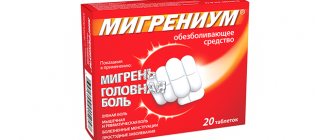Write a review
Reviews: 0
Manufacturers: Macfarlan Smith Limited
Active ingredients
- Morphine
Disease class
- Unstable angina
- Fever of unknown origin
- Acute pain
- Constant, unrelieved pain
- Trauma of unspecified location
- Surgical practice
Clinical and pharmacological group
- Not indicated. See instructions
Pharmacological action
- Analgesic (narcotic)
Pharmacological group
- Opioid narcotic analgesics
Substance-powder Morphine hydrochloride (Morphine hydrochloride)
Instructions for medical use of the drug
Description of pharmacological action
Stimulates mu, delta and kappa subtypes of opioid receptors. Inhibits the interneuronal transmission of pain impulses in the central part of the afferent pathway, reduces the emotional assessment of pain, the reaction to it, causes euphoria (mood improves, there is a feeling of mental comfort, complacency and bright prospects, regardless of the real state of affairs), which contributes to the formation of dependence (mental and physical). Reduces the excitability of the thermoregulation center, stimulates the release of vasopressin. It has virtually no effect on vascular tone. In high doses, it exhibits sedative activity, depresses the respiratory, cough and, as a rule, vomiting centers, stimulates the centers of the oculomotor (miosis) and vagus (bradycardia) nerves. Increases the tone of the smooth muscles of the gastrointestinal sphincters with a simultaneous decrease in peristalsis (locking effect). May stimulate the chemoreceptors of the vomiting center trigger zone and cause nausea and vomiting.
Indications for use
Severe pain syndrome (with myocardial infarction, unstable angina, trauma, in the postoperative period, with cancer), as an additional drug for premedication, epidural and spinal anesthesia.
Release form
powder substance; plastic bag (bag) of 1,2,3,5,10,20 and 25 kg, polypropylene container 1;
Pharmacodynamics
Stimulates mu, delta and kappa subtypes of opioid receptors. Inhibits the interneuronal transmission of pain impulses in the central part of the afferent pathway, reduces the emotional assessment of pain, the reaction to it, causes euphoria (mood improves, there is a feeling of mental comfort, complacency and bright prospects, regardless of the real state of affairs), which contributes to the formation of dependence (mental and physical). Reduces the excitability of the thermoregulation center, stimulates the release of vasopressin. It has virtually no effect on vascular tone. In high doses, it exhibits sedative activity, depresses the respiratory, cough and, as a rule, vomiting centers, stimulates the centers of the oculomotor (miosis) and vagus (bradycardia) nerves. Increases the tone of the smooth muscles of the gastrointestinal sphincters with a simultaneous decrease in peristalsis (locking effect). May stimulate the chemoreceptors of the vomiting center trigger zone and cause nausea and vomiting. The effect on mu receptors is associated with supraspinal analgesia, euphoria, physical dependence, respiratory depression, and stimulation of the vagus nerve centers. Stimulation of kappa receptors causes spinal analgesia, sedation, and miosis. Excitation of delta receptors causes analgesia.
Pharmacokinetics
It is quickly absorbed into the blood by any route of administration (orally, subcutaneously and intramuscularly). Easily passes barriers, incl. BBB, placental (can cause depression of the respiratory center in the fetus and therefore is not used for pain relief during labor). Metabolized, forming mainly glucuronides and sulfates. Excreted by the kidneys. Small amounts are secreted by all exocrine glands. The analgesic effect develops 5–15 minutes after subcutaneous and intramuscular administration, after oral administration - after 20–30 minutes and usually lasts 4–5 hours.
Use during pregnancy
During pregnancy and during breastfeeding, use is permissible only for health reasons (respiratory depression and the development of drug dependence in the fetus and newborn are possible).
Other special occasions at reception
Restrictions on use: general severe exhaustion, attack of bronchial asthma, COPD, arrhythmia, convulsions, drug dependence (including history), alcoholism, suicidal tendencies, emotional lability, surgical interventions on the gastrointestinal tract, urinary system; hypothyroidism, severe inflammatory bowel disease, prostatic hyperplasia, urethral stenosis, liver and/or renal failure, insufficiency of the adrenal cortex, old age (the metabolism and excretion of morphine slows down, its level in the blood increases).
Contraindications for use
Hypersensitivity, depression of the respiratory center, severe depression of the central nervous system, abdominal pain of unknown etiology, brain injury, intracranial hypertension, status epilepticus, acute alcohol intoxication, delirious psychosis, pulmonary heart failure due to chronic lung diseases, arrhythmia, paralytic ileus, post-mortem condition surgical intervention on the biliary tract, simultaneous treatment with MAO inhibitors, pregnancy, lactation, children under 2 years of age; with epidural and spinal analgesia (additionally): blood coagulation disorders (including during anticoagulant therapy), infections (risk of infection entering the central nervous system).
Side effects
From the nervous system and sensory organs: dizziness, headache, asthenia, anxiety, irritability, insomnia, nightmares, confusion, hallucinations, delirium, increased intracranial pressure, paresthesia, involuntary muscle twitching, convulsions, incoordination of movements, blurred vision, nystagmus , diplopia, miosis, ringing in the ears, changes in taste; against the background of large doses - muscle rigidity (especially respiratory); in children - paradoxical arousal; physical and mental dependence (after 1–2 weeks of regular use), withdrawal syndrome. From the cardiovascular system and blood (hematopoiesis, hemostasis): tachycardia/bradycardia, palpitations, decreased/increased blood pressure, fainting. From the respiratory system: depression of the respiratory center, bronchospasm, atelectasis. From the gastrointestinal tract: nausea, vomiting, constipation/diarrhea, dry mouth, anorexia, gastralgia, spasm of the biliary tract, cholestasis; in severe inflammatory bowel diseases - intestinal atony, paralytic ileus, toxic megacolon (constipation, flatulence, nausea, stomach cramps, vomiting). From the genitourinary system: decreased diuresis, spasm of the ureters (difficulty and pain when urinating, frequent urge to urinate), spasm of the bladder sphincter, impaired outflow of urine or aggravation of this condition with prostatic hyperplasia and stenosis of the urethra, decreased libido and/or potency . Allergic reactions: wheezing, facial flushing, facial swelling, tracheal swelling, laryngospasm, chills, itching, rash, urticaria. Other: increased sweating, dysphonia, weight loss, dehydration, pain in the extremities; local reactions - hyperemia, swelling, burning at the injection site.
Directions for use and doses
SC, IM or IV. The dosage regimen is individual, doses depend on the indications, route of administration, and patient's condition. The highest daily dose for adults is 50 mg (except for incurable cancer patients, in whom it can reach 1 g/day). Frequency of administration: every 12 hours.
Overdose
Symptoms of acute and chronic overdose: cold clammy sweat, confusion, dizziness, drowsiness, decreased blood pressure, nervousness, fatigue, miosis, bradycardia, severe weakness, slow difficulty breathing, hypothermia, anxiety, dry oral mucosa, delirious psychosis, intracranial hypertension (up to cerebrovascular accident), hallucinations, muscle rigidity, convulsions, in severe cases - loss of consciousness, respiratory arrest, coma. Treatment: resuscitation measures, intravenous administration of a specific antagonist of opioid analgesics - naloxone.
Interactions with other drugs
Extends and enhances the effect of drugs that depress the activity of the central nervous system, incl. sleeping pills, sedatives, drugs for general anesthesia, anxiolytics, neuroleptics and local anesthetics. Drugs that depress the central nervous system, incl. ethanol, enhance the depressive effect and respiratory depression (muscle relaxants also act). With systematic use of barbiturates, especially phenobarbital, there is a possibility of a decrease in the severity of the analgesic effect. Caution should be used simultaneously with MAO inhibitors due to possible overexcitation or inhibition with the occurrence of hyper- or hypotensive crises (initially, to assess the effect of interaction, the dose should be reduced to 1/4 of the recommended). When taken simultaneously with beta-blockers, it is possible to increase the inhibitory effect on the central nervous system, with dopamine - a decrease in the analgesic effect of morphine, with cimetidine - increased respiratory depression, with other opioid analgesics - increased depression of the central nervous system, respiration, hypotension. Chlorpromazine enhances the sedative and analgesic effects of morphine. Phenothiazine derivatives and barbiturates enhance the hypotensive effect and increase the risk of respiratory depression. Naloxone reduces the effect of opioid analgesics, as well as the respiratory and central nervous system depression they cause. Nalorphine reverses the respiratory depression caused by morphine. Strengthens the hypotensive effect of drugs that lower blood pressure (including ganglion blockers, diuretics). Competitively inhibits the hepatic metabolism of zidovudine and reduces its clearance (increases the risk of mutual intoxication). Drugs with anticholinergic activity, antidiarrheal drugs (including loperamide) increase the risk of constipation, including intestinal obstruction, urinary retention and central nervous system depression. Reduces the effect of metoclopramide. Morphine may increase the anticoagulant activity of coumarin and other anticoagulants.
Precautions for use
Morphine should not be used in situations where paralytic ileus may occur. If there is a risk of paralytic ileus, the use of morphine should be discontinued immediately. In patients undergoing cardiac surgery or other surgery with intense pain, the use of morphine should be discontinued 24 hours before surgery. If therapy is subsequently indicated, the dosage regimen is selected taking into account the severity of the operation. If nausea and vomiting occur, a combination with a phenothiazine can be used. During the treatment period, care must be taken when driving vehicles and engaging in other potentially hazardous activities that require increased concentration of attention and speed of psychomotor reactions, and avoid the use of ethanol. The simultaneous use of other drugs acting on the central nervous system (antihistamines, hypnotics, psychotropic drugs, other painkillers) is allowed only with the permission and under the supervision of a physician. It should be kept in mind that children under 2 years of age are more sensitive to the effects of opioid analgesics and may experience paradoxical reactions.
Storage conditions
In a place protected from light, at a temperature not exceeding 25 °C.
Best before date
36 months
ATX classification:
N Nervous system
N02 Analgesics
N02A Opioids
N02AA Opium alkaloids natural
N02AA01 Morphine
Content:
- Mechanism of action of morphine
- How long does it last?
- Use of high doses
- Morphine dosages
- When is morphine strictly contraindicated?
- Side effects that occur in morphine addicts
- Effect of morphine as a drug
Morphine is a strong narcotic drug.
Doctors use it as a pain reliever if pain symptoms cannot be relieved with safer analgesics. Thus, it is prescribed for serious traumatic injuries, oncology, traumatic shock, and after complex surgical interventions. If the doctor has a choice, he will always offer the patient a safer alternative. This is due to the side effects of morphine on the central nervous system, respiration, and gastrointestinal tract.
Similar drugs:
- Katadolon Capsule
- Ibuprom Max Oral tablets
- Solpadeine Effervescent tablets
- Milgamma compositum Dragee
- Mesipol Solution for intramuscular administration
- Xefocam (Xefocam) Lyophilisate for the preparation of solution for injection
- Melbek Solution for injection
- Efferalgan Rectal suppositories
- Mesulide Oral tablets
- Amidopyrinum Oral tablets
** The Drug Directory is intended for informational purposes only. For more complete information, please refer to the manufacturer's instructions. Do not self-medicate; Before you start using Morphine hydrochloride, you should consult your doctor. EUROLAB is not responsible for the consequences caused by the use of information posted on the portal. Any information on the site does not replace medical advice and cannot serve as a guarantee of the positive effect of the drug.
Are you interested in the drug Morphine hydrochloride? Do you want to know more detailed information or do you need a doctor's examination? Or do you need an inspection? You can make an appointment with a doctor - the Euro lab is always at your service! The best doctors will examine you, advise you, provide the necessary assistance and make a diagnosis. You can also call a doctor at home . Euro lab clinic is open for you around the clock.
** Attention! The information presented in this medication guide is intended for medical professionals and should not be used as a basis for self-medication. The description of the drug Morphine hydrochloride is provided for informational purposes and is not intended for prescribing treatment without the participation of a doctor. Patients need to consult a specialist!
If you are interested in any other drugs and medications, their descriptions and instructions for use, information about the composition and form of release, indications for use and side effects, methods of use, prices and reviews of drugs, or you have any other questions and suggestions - write to us, we will definitely try to help you.


